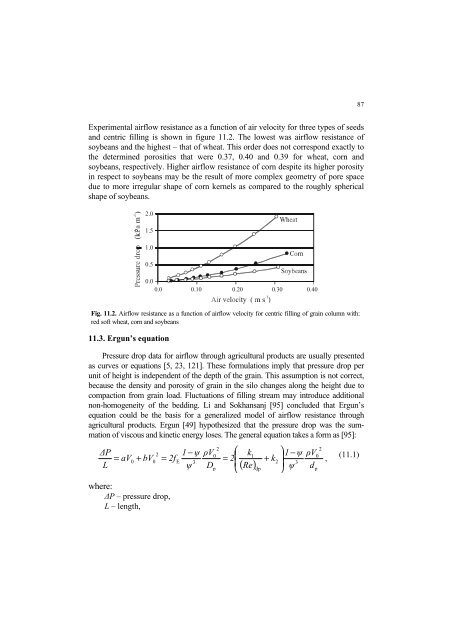Strona 2_redak - Instytut Agrofizyki im. Bohdana DobrzaÅskiego ...
Strona 2_redak - Instytut Agrofizyki im. Bohdana DobrzaÅskiego ...
Strona 2_redak - Instytut Agrofizyki im. Bohdana DobrzaÅskiego ...
You also want an ePaper? Increase the reach of your titles
YUMPU automatically turns print PDFs into web optimized ePapers that Google loves.
87<br />
Exper<strong>im</strong>ental airflow resistance as a function of air velocity for three types of seeds<br />
and centric filling is shown in figure 11.2. The lowest was airflow resistance of<br />
soybeans and the highest – that of wheat. This order does not correspond exactly to<br />
the determined porosities that were 0.37, 0.40 and 0.39 for wheat, corn and<br />
soybeans, respectively. Higher airflow resistance of corn despite its higher porosity<br />
in respect to soybeans may be the result of more complex geometry of pore space<br />
due to more irregular shape of corn kernels as compared to the roughly spherical<br />
shape of soybeans.<br />
<br />
<br />
<br />
<br />
<br />
<br />
Fig. 11.2. Airflow resistance as a function of airflow velocity for centric filling of grain column with:<br />
red soft wheat, corn and soybeans<br />
11.3. Ergun’s equation<br />
Pressure drop data for airflow through agricultural products are usually presented<br />
as curves or equations [5, 23, 121]. These formulations <strong>im</strong>ply that pressure drop per<br />
unit of height is independent of the depth of the grain. This assumption is not correct,<br />
because the density and porosity of grain in the silo changes along the height due to<br />
compaction from grain load. Fluctuations of filling stream may introduce additional<br />
non-homogeneity of the bedding. Li and Sokhansanj [95] concluded that Ergun’s<br />
equation could be the basis for a generalized model of airflow resistance through<br />
agricultural products. Ergun [49] hypothesized that the pressure drop was the summation<br />
of viscous and kinetic energy loses. The general equation takes a form as [95]:<br />
û3<br />
L<br />
⎛<br />
2<br />
2<br />
2 1 − % !90<br />
k1<br />
1 − % !90<br />
= aV0<br />
+ bV0<br />
= 2fE<br />
= 2⎜<br />
+ k ⎟<br />
3<br />
2<br />
,<br />
3<br />
% D<br />
p<br />
( Re) (11.1)<br />
dp<br />
% dp<br />
where:<br />
û3 – pressure drop,<br />
L – length,<br />
⎝<br />
⎞<br />
⎠
















